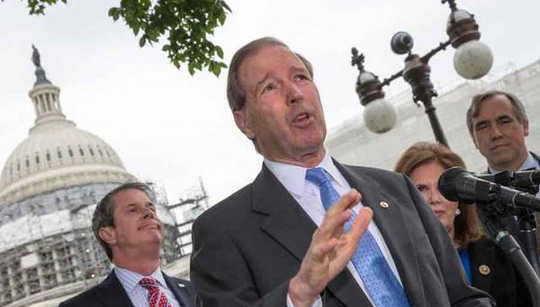
In a major overhaul of U.S. regulation of toxic chemicals, Congress last week passed the Frank R. Lautenberg Chemical Safety for the 21st Century Act, the largest piece of environmental legislation passed in the United States since 1990. President Obama is expected to sign it into law shortly.
The bill amends the 1976 Toxic Substances Control Act (TSCA), which has been called the “lapdog” of American environmental law because of its weak controls on hazardous chemicals. The new bill, named after the late New Jersey senator who championed the legislation, passed on a bipartisan basis with support from the chemical industry. The bill divided the environmental and public health communities.
While the new bill clearly gives the Environmental Protection Agency (EPA) more authority to test and restrict hazardous chemicals, it may not actually protect the public more effectively than current law. Because the legislation contains no new appropriations for EPA, allows chemical testing to proceed very slowly, and in some cases preempts states from enacting their own chemical restrictions, it could perpetuate toxic risks rather than reducing them.
The Outdated Toxic Substances Control Act
TSCA, passed in the Ford administration, is widely seen as one of the weakest U.S. environmental laws. TSCA gave EPA the power to order testing of chemicals, ban chemicals from the marketplace, restrict certain uses or require labeling. But the law created so many procedural hurdles for regulation that EPA was rarely able to exercise its authority.
More than 80,000 chemicals have been introduced into commerce in the United States, but EPA has issued testing orders for fewer than 300 in the past 40 years, and it has enacted restrictions on only six. When EPA has attempted to regulate chemicals under TSCA, manufacturers have frequently challenged the agency in court.
In 1991 a federal appeals court struck down EPA’s attempt to ban most uses of asbestos after the agency had spent years documenting the link between asbestos exposure and cancer and lung disease. Most experts believe that this court decision dealt a crippling blow to TSCA by making it nearly impossible to remove hazardous chemicals from the market.
Because of TSCA’s weaknesses, Americans are widely exposed to chemicals in the workplace, in food, and in consumer products for which there is little or no toxicity information. Dozens of chemicals that are known or probable carcinogens, as determined by the International Agency for Research on Cancer, continue to be sold in the United States. We don’t even know how many chemicals are currently in widespread use in the United States because TSCA does not require comprehensive reporting.
Because of inadequate resources at EPA and TSCA’s hurdles for obtaining toxicity data, the U.S. Government Accountability Office (GAO), the federal government’s in-house auditor, has included EPA’s chemicals programs on its list of “high risk” government programs since 2009. GAO lists programs as high risk when it considers them to be vulnerable to failure or ineffectiveness.
Despite TSCA’s well-known problems, Congress did not make serious efforts to reform the law until the Obama administration. By 2009, public health surveys had documented that numerous industrial chemicals were found in the blood and urine of Americans, and in 2010, the President’s Cancer Panel concluded that the “the true burden of environmentally induced cancers has been grossly underestimated.”
In response to rising public concern, states began enacting their own chemical regulations. As Senator Lautenberg and other legislators began to consider new federal legislation, the chemical industry quickly got behind the idea of TSCA reform because manufacturers feared having to comply with a patchwork of state chemical laws.
Key features of the Lautenberg Act
The new legislation makes several improvements to TSCA and gives the EPA much-needed new authority. For example, the law:
- requires EPA to make a safety determination for every new chemical before it hits the market
- establishes a system for prioritizing chemicals for safety reviews
- enhances EPA’s authority to require testing of both new chemicals and those already on the market
- clarifies that EPA should evaluate a chemical based on its risks to public health, without regard to the costs of regulation
- makes more data about chemicals available by limiting companies’ ability to claim trade secret protections.
But the real test of the bill is not whether it makes incremental improvements to TSCA; it is whether the bill actually protects Americans from chemical risks. Measured by that standard, the new bill does not go far enough and is likely to get bogged down in court just like the existing law.
For example, when EPA conducts safety reviews of chemicals, the bill requires the agency to determine whether a chemical poses an “unreasonable risk” to public health or the environment before it enacts any restrictions. But the legislation does not define this key term, and it is likely to take years of litigation to sort out what risks are “reasonable” and what risks are “unreasonable.”
Moreover, while the bill makes clear that EPA should not consider costs to industry in evaluating the risks of chemicals, it does force EPA to conduct a complicated cost-benefit analysis if it chooses to restrict a chemical. Manufacturers will inevitably challenge each step of this process in court.
Another major source of contention is whether this new federal law will supersede state laws. The chemical industry strongly supported federalizing chemical regulation to achieve uniformity. But many states have spent a decade or more developing their own chemical regulatory systems. California, Washington, Maine, Maryland and Minnesota have been leaders in this field, and their Congressional delegations opposed broad preemption of state law.
The resulting compromise undercuts states' ability to regulate chemicals on their own initiative. Under the bill, if EPA decides that a chemical meets a safety standard of no “unreasonable risk,” states are largely prevented from regulating that chemical. In addition, the new bill forecloses states from regulating a chemical as soon as EPA begins its safety review, even though safety reviews typically take several years.
The slow pace of chemical reviews is the bill’s greatest weakness. We lack safety data for tens of thousands of chemicals that are currently on the market, but the bill requires EPA to review only 20 chemicals in the first five years after it becomes law. At that pace, it will take the rest of this century to assess risks from the most commonly used chemicals in the United States. And the bill provides no new appropriations to speed up the pace of safety reviews.
No quick improvements
What will happen once the bill becomes law? Over the next year or so, EPA will begin ordering tests of a series of “Work Plan” chemicals that it has already flagged for attention. Work Plan chemicals that might be subject to testing include benzene, carbon tetrachloride, creosote, ethylene dibromide and nickel compounds. Manufacturers will perform the actual safety tests, and EPA is unlikely to propose restricting any chemicals under the new legislation for several years.
In the long run, the new law could identify severe public health risks from chemicals that are commonly used today. It could lead to changes in the composition of products ranging from cleaning supplies and plastics to furniture and medical devices. It also will require manufacturers to understand toxicity risks better before they bring new chemicals to market and introduce them into products.
But most of the so-called “existing” chemicals that have been in use for decades will be tested at a glacial pace. In a worst-case scenario, chemical manufacturers could hold up sensible protective regulations with years of litigation.
In sum, while the Lautenberg Act has some promising provisions, it simply does not go far enough to overcome the problems that have obstructed toxic chemical regulation in the United States for 40 years.
About The Author
![]() Noah M. Sachs, Professor of Law and Director, Robert M. Merhige Jr. Center for Environmental Studies, University of Richmond
Noah M. Sachs, Professor of Law and Director, Robert M. Merhige Jr. Center for Environmental Studies, University of Richmond
This article was originally published on The Conversation. Read the original article.
Related Books
at InnerSelf Market and Amazon
























